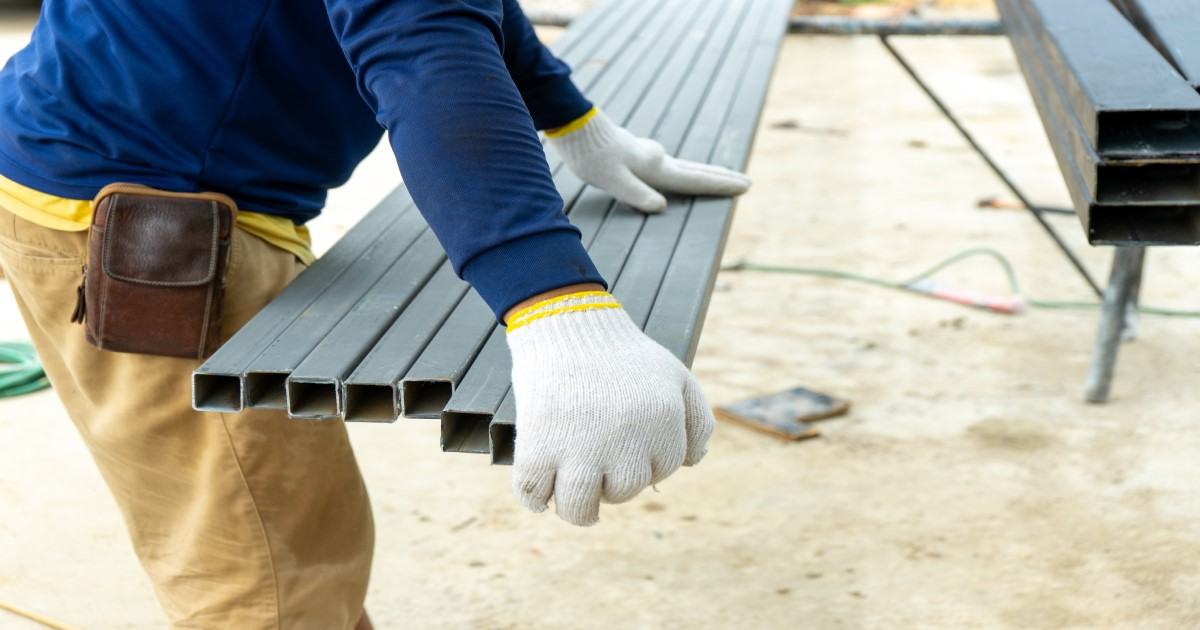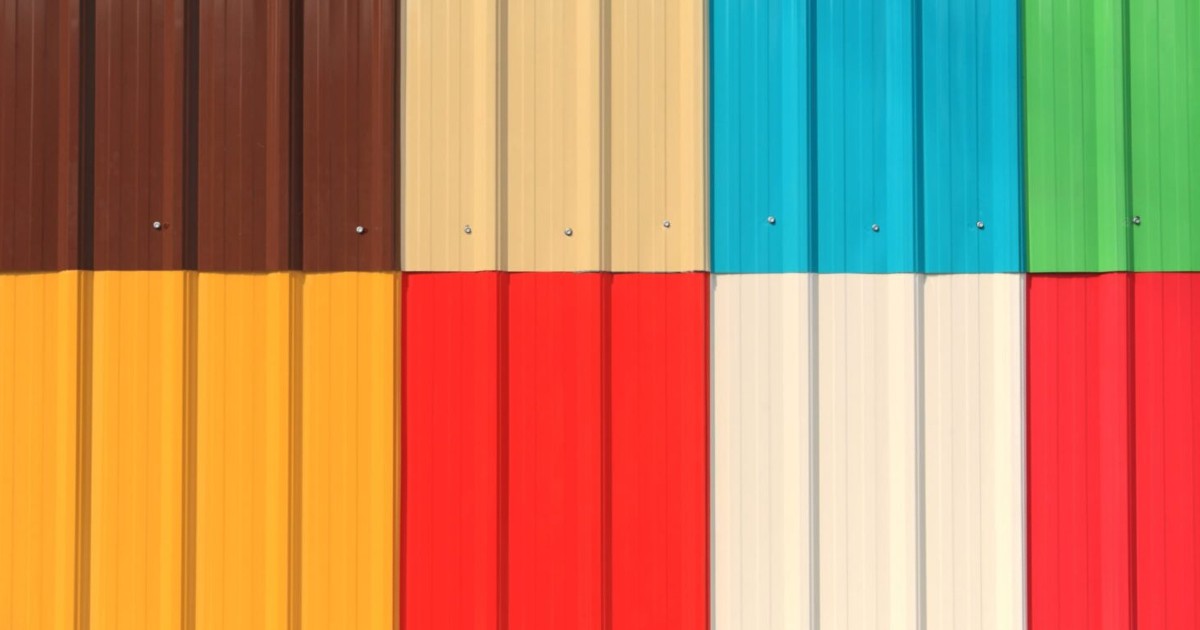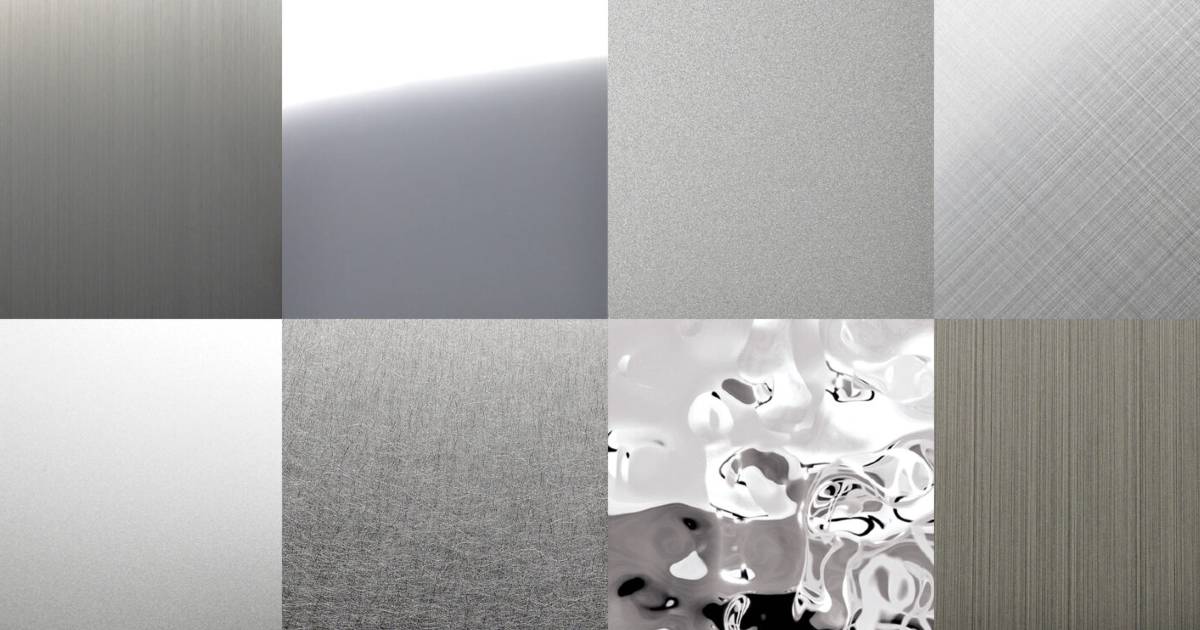Stainless steel finishes are for altering stainless steel surfaces’ appearance, texture, and performance. These finishes serve aesthetic and functional purposes, enhance visual appeal, improve corrosion resistance, simplify cleaning and maintenance, and ensure long-lasting durability.
With various stainless steel finishes available, such as mill finish, brushed finish, mirror finish, satin finish, bead blasted finish, patterned finish, and colored finish, understanding their characteristics and applications is good to know. This knowledge guides the selection of the most suitable finish for a specific application, ensuring the desired outcome in terms of aesthetics and performance. By choosing the appropriate finish, stainless steel surfaces can be tailored to meet any project’s functional requirements and visual preferences.
Types of Stainless Steel Finishes

Mill Finish
Definition and Characteristics
Mill finish is the standard surface finish applied to stainless steel after manufacturing. It is achieved through several steps, including hot rolling, annealing, and pickling.
During hot rolling, stainless steel is heated and passed through rollers to shape it into the desired form. This process leaves the surface with a characteristic rough texture. Next, the stainless steel undergoes annealing. It is the process of heating material to a specific temperature and slowly cooling it to enhance its mechanical properties.
After annealing, the stainless steel is pickled to remove any scale or impurities that may have formed on the surface during manufacturing. Pickling usually involves immersing the material in an acid solution or applying an acid paste to dissolve the unwanted oxides and contaminants. The result of these processes is a mill finish characterized by a dull, non-reflective appearance and a rough surface texture.
Common Applications
Mill-finish stainless steel finds widespread use in applications where aesthetics take a backseat to other considerations. It is particularly favored in constructing structural components, industrial equipment, and architectural elements that prioritize high strength and corrosion resistance over visual appeal. The rough texture and non-reflective appearance of mill-finish is ideal for such a purpose. Its durability and resistance to corrosion ensure longevity and reliability, while the lack of a polished or decorative finish allows for cost-effective manufacturing. Mill-finish stainless steel delivers practicality and performance in various demanding applications by focusing on functionality rather than aesthetics.
Pros and Cons
Mill-finish stainless steel offers several advantages, making it a preferred choice for various applications. Firstly, it provides excellent corrosion resistance, ensuring durability and longevity even in challenging environments. Its cost-effectiveness makes it an attractive option for projects with budget constraints. Mill-finish stainless steel’s strength and durability also make it suitable for heavy-duty applications that require robust materials. But, the rough surface texture of mill-finish stainless steel can make it more prone to dirt and debris accumulation, requiring more effort in cleaning and maintenance.
Brushed Finish

Definition and Characteristics
A brushed or satin finish on stainless steel is achieved through a mechanical brushing process that involves rubbing the surface with abrasive materials. This technique creates a pattern of fine lines or “brush strokes” on the metal, resulting in a smooth and uniform appearance. The brushed finish exhibits a ultra-fine sheen, adding an elegant touch to stainless steel surfaces.
Common Applications
Brushed finish stainless steel is widely used in architectural applications, including handrails, elevator panels, kitchen appliances, and decorative trim. Its clean and sophisticated look makes it popular in modern design and contemporary settings. The brushed finish complements various interior styles, adding a touch of refinement to both residential and commercial spaces.
Pros and Cons
Brushed finish stainless steel offers several advantages. Its attractive aesthetic appeals to those seeking a sleek and sophisticated appearance. The brushed texture also helps mask fingerprints and minor scratches, making it more forgiving in high-traffic areas. Cleaning brushed finish stainless steel is relatively simple, as it does not readily show smudges or watermarks.
But, one drawback of the brushed finish is its tendency to retain dirt and grime in the fine lines of the surface texture. Regular maintenance, including periodic cleaning, is necessary to keep the brushed finish looking its best. Despite this, the benefits of its attractive appearance and resistance to fingerprints and scratches often outweigh the need for additional upkeep.
Mirror Stainless Steel Finish
Definition and Characteristics
Mirror finish, a highly polished or No. 8 finish, is a stainless steel surface that has been mechanically polished to achieve a high level of reflectivity, resembling a mirror. This process involves progressively refining the texture with finer abrasives until a flawless and reflective appearance is obtained. The mirror finish gives a luxurious and striking aesthetic to stainless steel, improving its visual appeal and boosting the overall look of the material.
Common Applications
Mirror-finish stainless steel finds widespread use in decorative applications where an upscale and glamorous appearance is desired. It is commonly employed in architectural features, such as handrails, wall cladding, and decorative panels. Mirror-finish stainless steel is favored in automotive trim, jewelry, high-end kitchen appliances, and other luxury products. Its reflective surface creates a sense of depth and adds a touch of elegance to various settings.
Pros and Cons
Mirror-finish stainless steel has many advantages. It’s visual appeal and reflective properties make it a popular choice for projects that demand a high-end and sophisticated look. Mirror-finish stainless steel also possesses excellent corrosion resistance, ensuring longevity and durability in different environments. Cleaning is relatively straightforward, as the smooth surface minimizes the adhesion of dirt and grime.
But, mirror-finish stainless steel does have a few considerations. Due to its highly reflective surface, it is more prone to showing visible fingerprints, scratches, and smudges. Regular maintenance and cleaning are necessary to preserve its pristine appearance. Despite this requirement, the benefits of the mirror finish, including its stunning aesthetic and corrosion resistance, often outweigh the need for additional care and maintenance.
Satin Finish
Definition and Characteristics
Satin finish, a brushed or matte finish, is achieved by sanding the stainless steel surface using fine abrasives. This sanding process creates a smooth appearance with a low-gloss finish and a soft sheen. Unlike the brushed finish, the satin finish has shorter and finer brush strokes, resulting in a more refined texture.
Common Applications
Satin finish stainless steel is widely used in both architectural and industrial applications. It is commonly found on surfaces exposed to high traffic or wear, such as elevator doors, handrails, countertops, and kitchen appliances. The satin finish’s ability to resist visible scratches and smudges makes it highly suitable for areas where both aesthetics and durability are essential.
Pros and Cons
The attractive appearance of satin finish with a subtle sheen adds a touch of sophistication to any space. It is also resistant to fingerprints and minor scratches, making it easier to maintain a clean and pristine appearance. Cleaning satin finish stainless steel is simple, as it does not readily show smudges or watermarks.
But, satin finish stainless steel may show water spots more readily than other finishes. Regular wiping or drying is necessary to maintain its uniform appearance and prevent the formation of water spots. Despite this requirement, the benefits of its attractive aesthetic, resistance to fingerprints and scratches, and ease of cleaning make satin finish stainless steel a popular choice for various applications.
Bead Blasted Finish
Definition and Characteristics
A bead-blasted finish on stainless steel is achieved by subjecting the surface to high-pressure bombardment with fine glass or ceramic beads. This process creates a uniform and matte appearance with a slightly textured surface. Bead blasting can be tailored using different bead sizes to achieve various levels of texture, allowing for customization based on specific design requirements.
Common Applications
Bead-blasted finish stainless steel is widely employed in architectural applications, including wall panels, signage, and exterior cladding. It is particularly suitable for areas where a non-reflective surface is desired, such as restaurant countertops, kitchen sinks, and appliances. The bead-blasted finish adds a touch of sophistication and contemporary appeal to these applications.
Pros and Cons
The uniform appearance of bead-blasted finish stainless steel provides a consistent and visually appealing finish. It offers resistance to fingerprints and minor scratches, making it easier to maintain a clean and pristine look. The bead-blasted finish’s textured surface also helps hide surface imperfections, contributing to a smooth and aesthetically pleasing appearance.
But, a bead-blasted finish may show dirt and stains more readily than smoother finishes. Regular cleaning and maintenance are necessary. Despite this consideration, the benefits of its uniformity, resistance to fingerprints and scratches, and ability to hide imperfections make bead-blasted finish stainless steel a popular choice for many applications.
Patterned Finish
Patterned finish stainless steel showcases embossed or etched patterns on its surface, introducing texture and visual interest to the metal. This finish can be achieved through various techniques, including embossing, screen printing, or chemical etching, resulting in intricate and captivating designs.
Common Applications
Patterned finish stainless steel finds wide application in architecture, interior design, signage, and decorative panels. Its versatility allows for creating unique visual effects, adding depth and personality to various spaces. Patterned finish stainless steel is often utilized in wall cladding, elevator interiors, furniture accents, and other design elements.
Pros and Cons
The decorative appeal of patterned finish stainless steel makes it a popular choice for projects that require a distinctive and artistic touch. The patterned surface also has the added benefit of masking fingerprints and minor scratches, ensuring a cleaner and more pristine appearance. Patterned finish stainless steel is highly durable and can withstand daily wear and tear.
The intricate patterns of this finish may require more cleaning to remove dirt and debris that can build up within the crevices of the design. Regular maintenance is necessary to ensure the patterns remain visually appealing. Despite this, the decorative appeal, fingerprint resistance, and durability of patterned finish stainless steel make it an attractive option for those seeking unique and visually striking design elements.
Colored Finish

Definition and Characteristics
Colored finish stainless steel refers to applying a colored coating or finishes onto the surface of the stainless steel. You can achieve this through various methods, such as powder coating, electroplating, or physical vapor deposition (PVD). The colored finish ranges from subtle and muted hues to vibrant and bold shades, providing endless possibilities for customization and design.
Common Applications
Colored finish stainless steel is widely used in architectural design, interior decoration, signage, and consumer products. It offers the flexibility to incorporate specific colors into the stainless steel surface, allowing for personalized and creative expression. Color greatly enhances aesthetics in building facades, elevator interiors, furniture, lighting fixtures, and other decorative elements.
Pros and Cons
Colored finish stainless steel allows designers to add vibrancy, depth, and uniqueness to their designs, making a bold visual statement. The colored coating also protects against fingerprints and minor scratches, ensuring a cleaner and more polished appearance. Stainless steel’s durability and corrosion resistance remains intact beneath the color coating.
But, the color coating may be susceptible to wear over time, particularly in high-traffic areas or environments with abrasive conditions. Regular maintenance and care are necessary to preserve the color’s integrity and ensure the longevity of the finish. Despite this, the ability to infuse stainless steel with vibrant colors and its resistance to fingerprints and scratches make colored finish stainless steel the choice for those who want a personality and flair to their designs.
Factors Influencing Stainless Steel Finish Selection

Design Aesthetics and Desired Appearance
Whether the goal is to achieve a sleek, modern look or a textured, rustic appearance, the chosen finish should align with the intended aesthetic. The finish should match the surrounding materials and architectural style, enhancing the product’s or structure’s overall visual appeal. Factors such as the level of reflectivity, surface texture, and color options are integral in achieving the desired appearance.
Functionality and Performance Requirements
The stainless steel product or structure’s intended function and performance requirements are essential in determining the appropriate finish. Different finishes offer corrosion resistance, durability, ease of cleaning, and resistance to wear and tear. When considering applications in highly corrosive environments or situations with frequent contact with moisture, it is advisable to prefer finishes with enhanced corrosion resistance, such as a mirror or bead-blasted finish. It would be best to consider hygiene requirements, impact resistance, and potential chemical exposure.
Environmental Considerations
It plays a big role in selecting the appropriate finish. Different finishes offer varying levels of resistance to corrosion, oxidation, and degradation. Consider using finishes with superior corrosion resistance, such as a mirror or bead-blasted finish, in highly corrosive or marine environments where you expect exposure to saltwater, humidity, or harsh chemicals. When choosing a finish that will withstand specific environmental conditions, you should think about additional factors such as UV exposure, temperature changes, and airborne pollutants.
Maintenance and Cleaning Requirements
It would be best to consider the maintenance and cleaning demands for the chosen finish. Specific finishes are designed to resist fingerprints, scratches, or stains, making cleaning and maintaining them more accessible. This is particularly important in applications where frequent cleaning or maintenance is impractical or undesirable. Finishes that have a smooth surface or are non-porous are often easier to clean. Think about the available cleaning methods, frequency of maintenance, and the desired level of upkeep for selecting a finish that will meet the maintenance requirements of the application.
Cost Considerations
You should evaluate the cost of the finish and its impact on the overall budget. Different finishes vary in complexity, material requirements, and manufacturing processes, which can influence the price. Finishes such as mirrors or colored finishes may be more expensive because of the additional steps and materials involved in achieving the desired effect. Balancing the desired aesthetics and performance of the finish with the available budget is a must. It may be necessary to prioritize certain factors, such as functionality or durability, over others to align with the project’s financial constraints.
Selecting the Appropriate Finish
Stainless steel finishes come in various types, each offering unique characteristics and applications. These include mill finish, brushed finish, mirror finish, satin finish, bead blasted finish, patterned finish, and colored finish. Each finish contributes to the appearance, functionality, and performance of stainless steel products and structures. Choosing the right stainless steel finish involves considering design aesthetics, functionality, environment, maintenance requirements, and cost. Assessing these factors will help make an informed decision that meets the project’s visual and practical needs.
Stainless steel finishes are essential for enhancing the visual appeal, durability, and performance of stainless steel products and structures. By selecting the appropriate finish, one can achieve the desired aesthetic effect, improve corrosion resistance, and ensure ease of maintenance. It’s all a lot to think about, but if you put the time in, you will enjoy it for many years.
Frequently Asked Questions on Stainless Steel Finishes
Further Readings
Stainless Steel Finishing Options
Our Locations
Get a Quote Now
